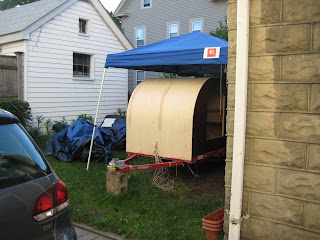Whew! Sorry for the lack of updates lately, but it has been a very busy couple of weeks for us outside of the trailer build. The whole intention of this project, which I hinted at in our very first
post, was that we wanted to 'turn-about' and begin new adventures, doing what we love. We finally set that in motion... we quit our jobs and are getting ready to pack up for the road! It has been a bit of a whirl wind of planning and finishing up, but we're well on our way. The goal is to be done with the trailer at the end of next week and to pack up and be out of Providence by August 1st! So we have lots to do!
But on to some actual trailer progress. Even though the electrical isn't completely finished, we decided since all of the wiring is run, we could still insulate and skin the main body of the trailer. The first step was to add some additional caulking to all of the remaining gaps next to the insulation and between the metal trailer and wood floor framing.
After everything was sealed up, we also needed to corral all of the wires so they wouldn't get damaged in the bending process.
I had a mini panic attack the night before we were set to start work because I realized once the plywood was on, we would have no idea where the spars were... how would we accurately attach it?! Then I realized if we just taped a small piece of masking tape to each spar so that it stuck out under the plywood, we would know there exact locations. Crisis averted!
We next marked on the trailer frame, where the plywood would start. We marked it about an 1 1/2" up from the bottom edge of the trailer frame (but for the life of me I can't remember why we did this!) Our neighbors cat came over to do quality control at this point. He has only three legs and is just about the friendliest cat I have ever met! I believe his name is Curtis, but we have dubed him 'Tripod Cat'... he doesn't seem to mind :)
We used the same method of bending the plywood as we explained on this hatch
post - soak the living daylights out of it and then ratchet it down into place. This was done before insulation because we didn't want any of it to get wet. After it was place, we admired the results and took a lunch break.
 |
| our super fun stove top toaster we got for the galley! |
We decided to used recycled denim insulation for the trailer roof. I had initially hoped to use a natural insulation throughout the trailer, but because our wall cavity was so narrow (1 1/2") foam insulation worked better. Since we had more space in the roof, I thought we could get back to a natural insulation here, plus a fiber insulation would be much easier to install around all the wires.
With the insulation in, it was time to permanently attach the roof skin! First, we needed to cut a hole for the wiring to pull though so we guesstimated a height to align with our future tongue box. We strung though the wires and put the plywood back on, holding it in place with the ratchet straps after pre-wetting the outside face. To attache it to the spars, we used 3/4" zinc coated steel construction screws (
spax brand). These worked really well since they had deep threads and we didn't have to pre-drill. The only problem was that the zinc coating was too thick on some of the screws so that it wouldn't catch in the wood. We had to inspect each screw before using it. To make sure the skin wouldn't move at all, we used five screws in each spar.

In the photos, it looks like we doubled up on some of the screws. We didn't... one of those holes is screwless. As we were attaching the plywood, we were only using the straps to hold it in place. We started screwing spar by spar from the bottom and working our way up. Unfortunately about four spars up, we noticed that the plywood was crooked. Not by alot, maybe a 1/4". However, the width of the trailer from the outside faces of the Okoume, is slightly wider than four feet. The drip edge we will be using is 1" wide with pre-drilled holes in the center. If the plywood remained crooked, when we screwed though the holes in the drip edge, it wouldn't catch the plywood. So everything had to come out, be repositioned, and re-screwed. This time we only installed two screws in each spar as we went up making sure everything stayed aligned, then screwed in the rest. Yay for wood filler!

Since one piece of plywood wouldn't reach all the way to the galley hatch, we had decided to use two. Before the framed opening to the fan, we had installed two spars. So we made sure to cut the first piece of plywood to end at the first spar and started the second piece at the one next to it. This second piece was much easier to install!
After it was all installed, Darrell carefully cut out the fan opening out with the craftsman multi-tool.
The outside skin is officially done! Except for the finish work and paint of course :)
































